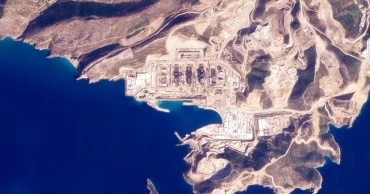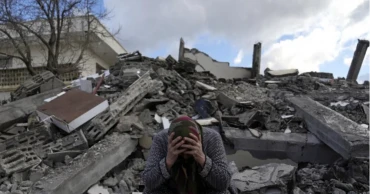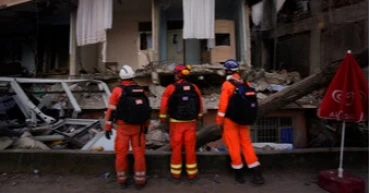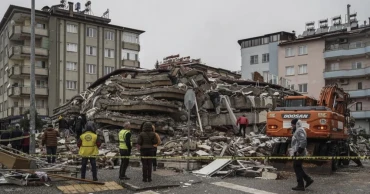quake
Turkey quake revives debate over nuclear plant being built
A devastating earthquake that toppled buildings across parts of Turkey and neighboring Syria has revived a longstanding debate locally and in neighboring Cyprus about a large nuclear power station being built on Turkey’s southern Mediterranean coastline.
The plant’s site in Akkuyu, located some 210 miles (338 kilometers) to the west of the epicenter of the Feb. 6 quake, is being designed to endure powerful tremors and did not sustain any damage or experience powerful ground shaking from the 7.8 magnitude earthquake and aftershocks.
But the size of the quake — the deadliest in Turkey’s modern history — sharpened existing concerns about the facility being built on the edge of a major fault line.
Rosatom, Russia’s state-owned company in charge of the project, says the power station is designed to “withstand extreme external influences” from a magnitude 9 earthquake. In nuclear power plant construction, plants are designed to survive shaking that is more extreme than what’s been previously recorded in the area they’re sited.
The possibility of a magnitude 9 earthquake occurring in the vicinity of the Akkuyu reactor “is approximately once every 10,000 years,” Rosatom told The Associated Press via email last week. “That is exactly how the margin of safety concept is being implemented.”
An official with Turkey’s Energy Ministry, when contacted by the AP, said there were no immediate plans to reassess the project. The official spoke on condition of anonymity in line with government protocol. Some activists, however, still say the project — the first nuclear power plant in Turkey — poses a threat.
Nuclear facilities are constructed of heavily reinforced concrete, sized for significant earthquake shaking and far more robust than commercial buildings, said Andrew Whittaker, a professor of civil engineering at the University at Buffalo who is an expert in earthquake engineering and nuclear structures.
The fact that it’s sited off the western end of the East Anatolian Fault, which was linked to last week’s powerful tremor, suggests that the design would have been checked for significant shaking, Whittaker added.
Still, Whittaker said, it would be prudent to reassess seismic hazard calculations in the region for all infrastructure, including the plant.
“There’s no reason to be concerned, but there’s always a reason to be cautious,” he said.
That’s little comfort to activists in Turkey and on both sides of ethnically divided Cyprus. They’ve renewed their calls for the project to be scrapped, saying that the devastating earthquake is clear proof of the great risk posed by a nuclear power plant near seismic fault lines.
In a statement to the AP, the Cyprus Anti-Nuclear platform, a coalition of over 50 Greek Cypriot and Turkish Cypriot environmentalist groups, trade unions and political parties, said it “calls on all political parties, scientific and environmental organizations and the civil society to join efforts and put pressure on the Turkish government to terminate its plans for the Akkuyu nuclear power plant.”
Cypriot European Parliament member Demetris Papadakis asked the European Commission what immediate actions it intends to take to halt the plant because of the dangers posed by building a nuclear power station in a seismic zone so close to Cyprus.
Nuclear power plants worldwide are designed to withstand earthquakes and shut down safely in the event of major earth movement — about 20% of nuclear reactors are operating in areas of significant seismic activity, according to the World Nuclear Association.
For example, Japanese nuclear plants, including the Hamaoka Nuclear Power Plant, are in regions where earthquakes of up to magnitude 8.5 may be expected, the association said. Stricter safety standards were adopted after the 2011 Fukushima nuclear disaster, when a tsunami crashed into the Daichi plant, melting three reactors and releasing dangerous levels of radiation. And the Diablo Canyon Power Plant in California was designed to safely withstand earthquakes, tsunamis and flooding that could potentially occur in the region too, according to its operator.
Turkish nuclear regulators provided the license for the plant’s construction in Akkuyu in 1976 following eight years of seismic studies to determine the most suitable location, but the project was slowed down after the Chernobyl nuclear accident in 1986. Construction of the first reactor started in 2018. Large nuclear power plants have traditionally taken a while to build because of the size, scale and complexity of the infrastructure, and delays associated with first-of-a-kind plants.
According to Rosatom, a study by Turkey’s Office for the Prevention and Elimination of Consequences of Emergency Situations indicates that the site in Akkuyu – some 60 miles (95 kilometers) from Cyprus’ northern coastline – is located in the fifth degree earthquake zone, which is considered the safest region in terms of earthquakes.
The plant design includes an external reinforced concrete wall and internal protective shell made of “prestressed concrete,” with metal cables stretched inside the concrete shell to give additional solidity to the structure, the company said. And the modern reactor design, Russia’s VVER-1200, includes an additional safety feature — a 144 ton steel cone called the “core catcher” that in an emergency, traps and cools any molten radioactive materials, Rosatom added.
The company emphasized that power units with VVER-1200 reactors comply with the post-Fukushima requirements of the International Atomic Energy Agency.
There’s a political dimension to qualms about the plant: Cyprus has accused Turkey of augmenting the Turkish Cypriots’ dependence on it in order to entrench the island’s ethnic division. Turkey has said it would supply the breakaway Turkish Cypriot north of the island with electricity through an undersea cable. A pipeline suspended a couple of hundred meters under the Mediterranean’s surface is already supplying the north with water.
The plant, whose first of four reactors is scheduled to go online later this year, will have a total capacity of 4,800 megawatts of electricity, providing about 10% of Turkey’s electricity needs. According to government figures, if the power plant started operating today, it could singlehandedly provide enough electricity for a city of about 15 million people, such as Istanbul, Rosatom added.
It’s estimated to cost $20 billion. Rosatom has a 99.2% stake in the project, and is contracted to build, maintain, operate and decommission the plant.
___
McDermott reported from Providence, Rhode Island. Suzan Fraser, in Ankara, Turkey, contributed.
2 years ago
Philippines quake causes hospital evacuation, minor damage
A strong earthquake rocked a central Philippine province on Thursday, sending people out of their homes at night, prompting dozens of patients to be evacuated from a hospital and causing minor damage to a government coliseum and business establishments, officials said.
There were no immediate reports of injuries or major damage from the magnitude 6 quake that was set off by a local fault line at a depth of 10 kilometers (6 miles), about 11 kilometers (6.8 miles) west of the coastal town of Batuan in Masbate province, officials said.
The quake struck about two hours after midnight, rousing many people from their sleep, Masbate provincial disaster-mitigation officer Adonis Dilao said.
“The first jolt was really strong followed by shaking that woke me up and my baby,” Red Cross officer MJ Oxemer told The Associated Press by telephone from the provincial capital of Masbate city. “We could hear the rumbling of the ground.”
Dozens of patients from a Masbate provincial hospital were evacuated but later brought back after the quake caused some cracks in the three-story building. A part of the ceiling on a small government coliseum in Masbate city was also damaged, Dilao said.
Cracks were also spotted in the concrete pillars of some business establishments, including grocery and drug stores in Masbate city’s downtown area, and in some houses, Dilao told The AP by telephone.
Although business owners have discretion when to reopen, Dilao said they should heed the advice of government safety inspectors because at least two strong aftershocks were felt following the quake. “Unlike typhoons, which can be predicted to give people time to brace, earthquakes can just suddenly hit,” he said.
The quake knocked out power in many areas of Masbate and nearby Ticao island, and some school classes were suspended, the Office of Civil Defense said, adding that damage assessments by local officials were underway.
The Philippines lies along the Pacific “Ring of Fire,” an arc of faults around the Pacific Ocean where most of the world’s earthquakes occur. Each year it is also hit by about 20 typhoons and tropical storms, making it one of the world’s most disaster-prone countries.
A magnitude 7.7 quake killed nearly 2,000 people in the northern Philippines in 1990.
2 years ago
UN appeals for $397 million to help Syrian quake survivors
The United Nations chief launched a $397 million appeal Tuesday to help nearly 5 million survivors of last week’s devastating earthquake in rebel-held northwest Syria who have received very little assistance because of deep divisions exacerbated by the country’s 12-year war.
Secretary-General Antonio Guterres announced the appeal a day after he welcomed an agreement between the U.N. and Syrian President Bashar Assad to open two new crossing points from Turkey for an initial period of three months. The U.N. has only been allowed to deliver aid to the northwest Idlib area through a single crossing at Bab Al-Hawa -- at Syrian ally Russia’s insistence. Since the quake, the U.N. says 84 trucks have gone through Bab Al-Hawa.
Guterres said the devastation from the magnitude 7.8 earthquake that ravaged southern Turkey and northwestern Syria on Feb. 6 “is one of the worst in recent memory,” and “we all know that lifesaving aid has not been getting in at the speed and scale needed.”
He said the $397 million will provide “desperately needed, life-saving relief for nearly 5 million Syrians — including shelter, health care, food and protection” for three months.
Guterres said the U.N. is in the final stages of preparing an emergency appeal for quake-ravaged southern Turkey. U.N. spokesman Stephane Dujarric said the appeal will be launched “probably in the coming days.”
He urged the international community to provide the emergency funding without delay, saying: “The human suffering from this epic natural disaster should not be made even worse by manmade obstacles — access, funding, supplies.”
The secretary-general said aid to Syria must get through by all routes to all areas without restrictions.
Read more: Rising toll makes quake deadliest in Turkey's modern history
A senior U.N. World Food Program official warned that food insecurity in afflicted parts of Syria had been rising drastically even before the earthquake struck.
“It was very bad before. Now it’s dramatic,” said Corinne Fleischer, the agency’s Middle East Director.
“Half of the population faces hunger. And that’s the worst that we’ve seen since the beginning of the crisis in Syria. Even at the height of the war, we didn’t have 12 million people food insecure,” she said in an interview with the Associated Press.
Guterres announced that an 11-truck convoy was on the move to go through one of the newly opened crossings at Bab Al-Salam, “with many more to come.” He said the second new crossing at Al Raée is also open, “and goods are flowing.”
Dujarric said the convoy went through the crossing without any obstacles and “we’re very optimistic that things will move quickly.” He noted that the two crossings have been used by relief organizations not affiliated with the U.N. and the roads are in better condition than those leading to Bab Al-Hawa.
The announcement of the two additional crossings from Turkey came as the U.N. Security Council was meeting for the first time Monday afternoon on the difficulties of getting aid to northwest Syria.
The U.N. has also been trying to send a convoy to the northwest across conflict lines within Syria, but it hasn’t gotten a green light from all parties. The convoy has reportedly been blocked by Hayat Tahrir al-Sham, a rebel group with ties to al-Qaida that controls part of the northwest.
France’s U.N. ambassador, Nicolas De Riviere, told reporters before Monday’s council meeting that there were two options — either the Syrian government grant additional access to the northwest or the council would try to adopt a resolution authorizing additional crossing points to the region.
After the meeting and the announcement of the two new crossings, De Riviere said there should be no “obstacles” to delivering aid through the three crossings. If there are, he said, the Security Council should look into adopting a resolution under Chapter 7 of the U.N. Charter, which means it can be enforced militarily, to authorize the crossings and get aid to the millions in need.
U.S. Ambassador Linda Thomas-Greenfield said the United States will be watching closely to see if aid is getting to Syrians in need and will push for a U.N. resolution if it isn’t. “It took seven days to get this decision to allow the borders to be open -- that decision should have been made on day one,” she said.
Secretary-General Guterres, asked about a possible meeting with president Assad, said what’s needed now is not high-level visits that divert resources but stepped-up relief efforts.
“I am following that very, very closely,” he said, “and whenever it would be useful and positive, I am ready to do whatever is needed.”
As for whether a Security Council resolution is needed, he reiterated that the two new crossings are open, “and we will see, of course, if the situation would change, we would adopt the necessary measures.”
2 years ago
Rising toll makes quake deadliest in Turkey's modern history
Turkish President Recep Tayyip Erdogan announced Tuesday that more than 35,000 people have died in Turkey as a result of last week’s earthquake, making it the deadliest such disaster since the country’s founding 100 years ago.
While the death toll is almost certain to rise even further, many of the tens of thousands of survivors left homeless were still struggling to meet basic needs, like finding shelter from the bitter cold.
Confirmed deaths in Turkey passed those recorded from the massive Erzincan earthquake in 1939 that killed around 33,000 people.
Erdogan said 105,505 were injured as a result of the Feb. 6 quake centered around Kahramanmaras and its aftershocks. Almost 3,700 deaths have been confirmed in neighboring Syria, taking the combined toll in both countries to over 39,000.
The Turkish president, who has referred to the quake as “the disaster of the century,” said more than 13,000 people were still being treated in hospital.
Speaking in Ankara following a five-hour Cabinet meeting held at the headquarters of disaster agency AFAD, Erdogan said 47,000 buildings, which contained 211,000 residences, had been destroyed or were so badly damaged as to require demolition.
“We will continue our work until we get our last citizen out of the destroyed buildings,” Erdogan said of ongoing rescue efforts.
Aid agencies and governments were stepping up efforts to bring help to devastated parts of Turkey and Syria.
The situation was particularly desperate in Syria, where a 12-year civil war has complicated relief efforts and meant days of wrangling over how to even move aid into the country, let alone distribute it. Some people there said they have received nothing. In Turkey, meanwhile, families huddled in train cars.
The Syrian Health Ministry announced a final count of 1,414 deaths and 1,357 injuries in areas under government control.
Read more: UN appeals for $397 million to help Syrian quake survivors
On Tuesday, the United Nations launched a $397 million appeal to provide “desperately needed, life-saving relief for nearly 5 million Syrians” for three months. It came a day after the global body announced a deal with Damascus to deliver U.N. aid through two more border crossings from Turkey to rebel-held areas of northwest Syria — but the needs remained enormous.
Ahmed Ismail Suleiman set up a shelter of blankets outside his damaged house in the town of Jinderis, one of the worst-hit communities in northwest Syria. He was afraid to move his family back into a house that might not be structurally sound, so 18 people slept outside under the makeshift tent.
Read more: Syria's Assad could reap rewards from aid crossing deal
“We sit but can’t sleep lying down here," he said. “We are waiting for a proper tent.”
Mahmoud Haffar, head of the town council, said residents have been able to scrounge up about 2,500 tents so far, but some 1,500 families still remain without shelter — as nighttime temperatures fall to around minus 4 degrees Celsius (26 degrees Fahrenheit).
“We are ... still hearing the question of when will aid get in,” said Haffar.
While tents have been in short supply, one women said the town had a surplus of donated bread and water.
To the southwest, in government-held Latakia, Raeefa Breemo said only those packing into shelters seemed to be getting aid.
“We need to eat, we need to drink, we need to survive. Our jobs, our lives, everything have stopped," Breemo said.
Offers of help — from rescue crews and doctors to generators and food — have come from around the world, but the needs remain immense after the magnitude 7.8 quake and powerful aftershocks toppled or damaged tens of thousands of buildings, destroyed roads and closed airports for a time. The quake affected 10 provinces in Turkey that are home to some 13.5 million people, as well as a large area in northwest Syria that is home to millions.
Much of the water system in the quake-hit region was not working, and Turkey’s health minister said samples from dozens of points of the system showed the water was unsuitable to drink.
In the Turkish port city of Iskenderun, displaced families have sheltered in train carriages since last week.
While many have left in recent days for nearby camps or other parts of Turkey, dozens of people were still living in the trains on Tuesday.
“The wagons have become our home,” 50-year-old Nida Karahan told Anadolu Agency.
While a first Saudi aid plane, carrying 35 tons of food, landed in Syrian government-held Aleppo on Tuesday, getting aid to the country's rebel-held Idlib has been especially complicated.
Until Monday’s deal between the U.N. and the Syrian government of President Bashar Assad, the global body had only been allowed to deliver aid to the area through a single border crossing with Turkey, or via government territory.
The newly opened crossings at Bab al-Salam and Al Raée are to function for an initial period of three months. Russia bristled at suggestions that the opening of the crossings might be made permanent, and its Foreign Ministry accused the West of trying to get aid “exclusively” to areas not controlled by the Syrian government.
Major humanitarian organizations welcomed the development but cautioned that logistical problems remain, even as the first U.N. aid convoy with 11 trucks entered northwestern Syria through Bab al-Salam Tuesday.
“This is a constant back and forth in negotiations,” said World Health Organization spokesman Christian Lindmeier. “Every party has to agree to receive convoys.”
The death toll in both countries is nearly certain to rise as search teams turn up more bodies — and the window for finding survivors was closing.
Nevertheless, more than 200 hours after the quake struck, teacher Emine Akgul was pulled from an apartment building in Antakya by a mining search and rescue team, Turkey's state-run Anadolu news agency reported.
In Adiyaman province, rescuers reached 18-year-old Muhammed Cafer Cetin, and medics gave him an IV with fluids before attempting a dangerous extraction from a building that crumbled further as rescuers were working. Medics fitted him with a neck brace and he was carted away on a stretcher with an oxygen mask, Turkish TV showed.
Many in Turkey have blamed faulty construction for the vast devastation, and authorities continued targeting contractors allegedly linked with buildings that collapsed. Turkey has introduced construction codes that meet earthquake-engineering standards, but experts say the codes are rarely enforced.
Erdogan announced Tuesday that the government planned to start construction of 30,000 houses in March.
“Our aim is to complete the construction of high quality and safe buildings in a year to meet the housing need in the entire earthquake zone,” he said.
At a temporary shelter in a sports center in Afrin in northwest Syria, 190 families were sleeping on the floor of a basketball court, lying on mats typically used for training. The families attempted to create a semblance of privacy by hanging blankets on columns or sports bars.
Sabah el Khodr said she and her two toddlers have been sick for the last nine days. The children were wrapped in blankets and sleeping on the floor of the court.
Local officials said the shelter is temporary, until new tents are secured.
2 years ago
Rescuers find more alive in Turkey on 8th day after quake
Rescuers on Tuesday were working to reach people under the rubble in three provinces hit hard by the devastating quakes that hit Turkey and Syria last week.
The death toll from the magnitude 7.8 and 7.5 quakes that struck nine hours apart on Feb. 6 in southeastern Turkey and northern Syria passed 35,000, and was certain to increase as search teams find more bodies.
Turkish television continued broadcasting rescues Tuesday, as experts said the window to find survivors is closing.
In Adiyaman province, rescuers reached 18-year-old Muhammed Cafer Cetin, and medics gave him an IV with fluids before attempting a dangerous extraction from a building that crumbled further as rescuers were working. Medics surrounded him to place a neck brace and he was on a stretcher with an oxygen mask, making it out to daylight on the 199th hour. “We are so happy,” his uncle said.
Read More: Search for earthquake survivors enters final hours in Turkey
Two others were rescued from one building that’s been destroyed in central Kahramanmaras, near the epicenter, Tuesday some 198 hours after the quake. Broadcaster Haberturk said one was 17-year-old Muhammed Enes, who was seen wrapped in a thermal blanket and carried on a stretcher to an ambulance. Dozens of rescuers were working at the site and Turkish soldiers hugged and clapped after their rescue.
Rescuers then asked for quiet to continue looking for others and shouted “can anyone hear me?"
The health conditions of the rescued were unclear.
In extremely hard-hit Hatay, Sengul Abalioglu lost her old sister and four nephews. “It doesn't matter if dead or alive, we just want our corpses so that they at least have a grave and we bury them,” she told The Associated Press, devastated as she waited in front of the rubble where her family could be.
In Syria, President Bashar Assad agreed to open two new crossing points from Turkey to the country’s rebel-held northwest to deliver desperately needed aid and equipment to millions of earthquake victims, the United Nations announced Monday. The crossings at Bab Al-Salam and Al Raée will be opened for an initial period of three months. Until now, the U.N. has only been allowed to deliver aid to the Idlib area through a single crossing at Bab Al-Hawa.
The United Nations has been under intense pressure to get more aid and heavy equipment into Syria’s rebel-held northwest since the earthquake struck a week ago, with survivors lacking the means to dig for other survivors and the death toll mounting.
The first Saudi aid plane, carrying 35 tons of food, landed in government-held Aleppo airport Tuesday morning, according to Syrian state media. Saudi Arabia has raised some $50 million dollars in a public campaign to aid Turkey and Syria. Prior to Tuesday, Saudi planes landed in Turkey, with Saudi trucks also delivering some aid into impoverished rebel-held northwestern Syria.
Several other Arab countries have sent planes loaded with aid to government-held Syria, including Jordan and Egypt, the United Arab Emirates. Algeria, Iraq, Oman, Tunisia, Sudan and Libya have also delivered aid to Damascus.
Turkish Vice President Fuat Oktay said late Monday rescue work continued in Hatay province, along with Kahramanmaras — the epicenter — and Adiyaman. Rescue work appears to have ended in the remaining seven provinces.
The quake affected 10 provinces in Turkey that are home to some 13.5 million people, as well as a large area in northwest Syria that is home to millions.
Quake survivors also face difficult conditions amid wrecked cities, with many sleeping outdoors in freezing weather. Much of the region's water system is not working, and damage to the system raises risks of contamination. Turkey’s health minister said samples taken from dozens of points of the water system were “microbiologically unfit,” which highlights how precarious basic needs continue to be.
More than 41,500 buildings were destroyed or so damaged that they would have to be demolished, the Minister of Environment and Urbanization. There are bodies under those buildings and the number of missing remain unclear.
Many in Turkey blame faulty construction for the vast devastation, and authorities continued targeting contractors allegedly linked with buildings that collapsed. Turkey has introduced construction codes that meet earthquake-engineering standards, but experts say the codes are rarely enforced.
The death toll in Turkey stood at 31,643 as of Monday. Officials have decreased the frequency of death toll updates since the first week of the response, now releasing larger updates once or twice a day.
The toll in the northwestern rebel-held region has reached 2,166, according to the rescue group the White Helmets, while 1,414 people have died in government-held areas, according to the Syrian Health Ministry in Damascus. The overall death toll in Syria stands at 3,580.
Turkish President Recep Tayyip Erdogan’s cabinet was scheduled to meet Tuesday.
___
Bilginsoy reported from Istanbul. Kareem Chehayeb contributed from Beirut and Edith M. Lederer contributed from New York.
2 years ago
After quake, war-hit Syrians struggle to get aid, rebuild
After years of war, residents of areas in northwest Syria struck by a massive earthquake are grappling with their new and worsening reality.
Almost one week after the devastating 7.8 magnitude earthquake struck northern Syria and neighboring Turkey, the United Nations has acknowledged an international failure to help Syrian quake victims.
In Atareb, a town that Syrian rebels still hold after years of fighting government troops, survivors dug through the debris of their homes Sunday, picking up the remnants of their shattered lives and looking for ways to heal after the latest in a series of humanitarian disasters to hit the war-battered area.
Excavators lifted rubble and residents with shovels and picks destroyed columns to even out a demolished building.
Dozens of newly displaced families gathered for hot meals from local volunteers and the local opposition-run government. A private citizen went tent to tent to give out wads of cash in a makeshift shelter — the equivalent of about $18 to each family.
Syrians were doing what they have honed over years of crises: relying on themselves to pick up the pieces and move on.
“We are licking our own wounds,” said Hekmat Hamoud, who had been displaced twice by Syria’s ongoing conflict before finding himself trapped for hours beneath rubble.
Syria's northwestern rebel-held enclave, where over 4 million people for years have struggled to cope with ruthless airstrikes and rampant poverty, was hit hard by the Feb. 6 quake.
Many in the area were already displaced from the ongoing conflict and live in crowded tent settlements or buildings weakened by past bombings. The quake killed over 2,000 people in the enclave, and displaced many more for a second time, forcing some to sleep under olive groves in the frigid winter weather.
“l lost everything,” said father of two Fares Ahmed Abdo, 25, who survived the quake. But his new home and body shop where he fixed motorcycles for a living were destroyed. Once again with barely any shelter and no power nor toilets, he, his wife, two boys and ill mother are crammed in a small tent.
“I am waiting for any help," he said.
Visiting the Turkish-Syrian border Sunday, U.N. Under-Secretary-General for Humanitarian Affairs Martin Griffiths acknowledged in a statement that Syrians have been left “looking for international help that hasn’t arrived.”
“We have so far failed the people in north-west Syria. They rightly feel abandoned,” he said. “My duty and our obligation is to correct this failure as fast as we can.”
Northwest Syria relies almost entirely on aid for survival, but post-quake international assistance has been slow to reach the area. The first U.N. convoy to reach the area from Turkey was on Thursday — three days after the earthquake.
Before that, the only cargo coming across the Bab al-Hawa crossing on the Turkey-Syria border was a steady stream of bodies of earthquake victims coming home for burial — Syrian refugees who had fled the war in their country and settled in Turkey but perished in the quake.
The U.N. aid sent from Turkey to Syria is only authorized to enter via the Bab al-Hawa crossing, and logistics were complicated by pressure on the roads, many of them destroyed by the quake. While technically, international aid can also be sent from Syrian government-held areas to rebel-held areas in the northwest, that route brings its own set of hurdles and was at best a trickle.
Critics of the government of President Bashar Assad say aid funneled through government-held areas in Syria faces bureaucracy and the risk that authorities will misappropriate or divert the aid to support people close to the government.
A convoy carrying U.N. aid that was scheduled to cross Sunday into rebel-held Idlib from the government area was canceled after its entry was blocked by the the Qaida-affiliated rebel group Hayat Tahrir al-Sham, which dominates the area. An administrative arm of the group said in a statement declined to receive assistance from government areas.
Strips of northern Syria are held by a patchwork of sometimes-conflicting groups, further hindering aid deliveries. Turkish-backed rebels have blocked aid convoys from reaching earthquake victims that were sent by rival U.S.-backed Kurdish groups in neighboring areas.
“We are trying to tell everyone, put politics aside. This is the time to unite behind the common effort to support the Syrian people," said Geir Pedersen, the U.N. special envoy for Syria who landed in Damascus on Sunday.
At the United Nations, U.S. envoy Linda Thomas-Greenfield called for an urgent U.S. Security Council vote to authorize the opening of additional cross-border passages into northwestern Syria." People in the affected areas are counting on us," she said in a statement. “They are appealing to our common humanity to help in their moment of need. We cannot let them down.”
While aid has been slow to reach the northwest, a number of countries that had cut ties with Damascus during Syria's civil war have sent help to government areas. Arab countries including Egypt and the United Arab Emirates have stepped in. UAE's foreign minister visited Damascus and met with Assad on Sunday.
Raed al-Saleh, the head of the White Helmets, a civil defense group operating in the rebel-held northwest, said Griffiths' visit was “too little, too late.” He said calls for international assistance by local rescue teams went unheeded for days “and during this time, countless lives have been needlessly lost.”
Al-Saleh met with Griffiths to demand the opening of additional cross-border routes for aid to enter without waiting for authorization from the U.N. Security Council.
Abdel-Haseeb Abdel-Raheem sifted through the rubble of his aunt’s destroyed four-story building in the town of Atareb in opposition-run northern Aleppo. He had pulled the bodies of his aunt and her husband from beneath the rubble hours after the quake. Now he went back to find any valuables, using his hands and dipping his body inside the skeleton of the destroyed building to pull out blankets and pillows, as well as some clothes.
The 34-year-old said he had no illusion that humanitarian assistance will solve his problems.
“We have no hope anymore,” he said.
___
Associated Press writers Kareem Chehayeb and Abby Sewell in Beirut contributed to this report.
2 years ago
Rescuers rejoice as more quake survivors emerge from rubble
Six relatives huddled in a small air pocket, day after day. A desperate teenager grew so thirsty that he drank his own urine. Two frightened sisters were comforted by a pop song as they waited for rescuers to free them.
These earthquake survivors were among more than a dozen people pulled out of the rubble alive Friday after spending over four days trapped in frigid darkness following the disaster that struck Turkey and Syria.
The unlikely rescues, coming so long after Monday’s 7.8-magnitude quake brought down thousands of buildings, offered fleeting moments of joy amid a catastrophe that has killed nearly 24,000 people, injured at least 80,000 others and left millions homeless.
In the Mediterranean coastal city of Iskenderun, a crowd chanted “God is great!” as Haci Murat Kilinc and his wife, Raziye, were carried on stretchers to a waiting ambulance.
“You’ve been working so many hours, God bless you!” a relative of the couple told one of their saviors.
One rescue worker said that Kilinc had been joking with crew members while still trapped beneath the rubble, trying to boost their morale.
Two hours earlier in Kahramanmaras, the city closest to the epicenter, rescuers embraced and chanted their thanks to God after pulling a man from his collapsed home.
In Adiyaman, a hard-hit city of more than a quarter-million people, rescuers and onlookers suppressed their joy so as not to frighten 4-year-old Yagiz Komsu as he emerged from the debris, according the HaberTurk television, which broadcast the rescue live.
Also read: Bangladeshi rescue team starts operations in Turkey
To distract him, he was given a jelly bean. Teams later rescued his 27-year-old mother, Ayfer Komsu, who had a broken rib.
But the flurry of dramatic rescues could not obscure the devastation spread across a sprawling border region that is home to more than 13.5 million people. Entire neighborhoods of high-rises have been reduced to rubble, and the quake has already killed more people than Japan’s Fukushima earthquake and tsunami, with many more bodies yet to be recovered and counted.
Relatives wept and chanted as rescuers pulled 17-year-old Adnan Muhammed Korkut from a basement in the Turkish city of Gaziantep, near the quake’s epicenter. He had been trapped for 94 hours, forced to drink his own urine to survive.
“Thank God you arrived,” he said, embracing his mother and others who leaned down to kiss and hug him as he was being loaded into an ambulance.
For one of the rescuers, identified only as Yasemin, Adnan’s survival hit home hard.
“I have a son just like you,” she told him after giving him a warm hug. “I swear to you, I have not slept for four days. … I was trying to get you out.”
Elsewhere, HaberTurk television said rescuers had identified nine people trapped inside the remains of a high-rise apartment block in Iskenderun and pulled out six of them, including a woman who waved at onlookers as she was being carried away on a stretcher. The crowd shouted “God is great!” after she was brought out.
The building was only 600 feet (200 meters) from the Mediterranean Sea and narrowly avoided being flooded when the massive earthquake sent water surging into the city center.
Video of another rescue effort in Kahramanmaras showed an emergency worker playing a pop song on his smartphone to distract the two teenage sisters as they waited to be freed.
There were still more stories: A German team said it worked for more than 50 hours to free a woman from a collapsed house in Kirikhan. And a trapped woman could be heard speaking to a team trying to dig her out in video broadcast by HaberTurk television. She told her would-be rescuers that she had given up hope of being found — and prayed to be put to sleep because she was so cold. The station did not say where the operation was taking place.
Even though experts say trapped people can live for a week or more, the odds of finding more survivors were quickly waning.
Death loomed everywhere: Morgues and cemeteries were overwhelmed, and bodies wrapped in blankets, rugs and tarps lay in the streets of some cities.
Temperatures remained below freezing across the large region, and many people have no shelter. The Turkish government has distributed millions of hot meals, as well as tents and blankets, but was still struggling to reach many people in need.
The disaster compounded suffering in a region beset by Syria's 12-year civil war, which has displaced millions of people within the country and left them dependent on aid. The fighting sent millions more to seek refuge in Turkey.
The conflict has isolated many areas of Syria and complicated efforts to get aid in. The United Nations said the first earthquake-related aid convoy crossed from Turkey into northwestern Syria on Friday — a day after an aid shipment planned before the disaster arrived.
The U.N. refugee agency estimated that as many as 5.3 million people have been left homeless in Syria. Sivanka Dhanapala, the country representative in Syria for UNHCR, told reporters Friday that the agency is focusing on providing tents, plastic sheeting, thermal blankets, sleeping mats and winter clothing.
Syrian President Bashar Assad and his wife, Asmaa, visited survivors at the Aleppo University Hospital, according to Syrian state media. It was the leader's first public appearance in an affected area of the country since the disaster. He then visited rescuers in one of the city's hardest-hit areas.
Aleppo has been scarred by years of heavy bombardment and shelling — much of it by the forces of Assad and his ally, Russia — and it was among the cities most devastated by the earthquake.
The Syrian government also announced that it will allow aid to reach all parts of the country, including areas held by insurgent groups in the northwest.
Also Friday, the outlawed Kurdistan Workers’ Party, or PKK, declared a cease-fire in its separatist insurgency in Turkey’s mainly Kurdish southeast, including some areas affected by the quake.
Turkey’s disaster-management agency said more than 20,200 people had been confirmed killed in the disaster so far in Turkey, with more than 80,000 injured.
More than 3,500 have been confirmed killed in Syria, bringing the total number of dead to nearly 24,000.
Some 12,000 buildings in Turkey have either collapsed or sustained serious damage, according to Turkey’s minister of environment and urban planning, Murat Kurum. Turkey's vice president, Fuat Oktay, said more than 1 million people were being housed in temporary shelters.
Engineers suggested that the scale of the devastation was partly explained by lax enforcement of building codes.
2 years ago
Death toll from catastrophic earthquake hitting Turkey, Syria goes beyond 20,700
Rescuers pulled more survivors from beneath the rubble of collapsed buildings Thursday, but hopes were starting to fade of finding many more people alive more than three days after a catastrophic earthquake and series of aftershocks hit Turkey and Syria, killing more than 20, 700.
Emergency crews working through the night in the city of Antakya were able to pull a young girl, Hazal Guner, from the ruins of a building and also rescued her father, Soner Guner, two hours later, news agency IHA reported.
As they prepared the man to be loaded into an ambulance, rescue crews told him that his daughter was alive and they were taking him to the same field hospital for treatment.
“I love you all,” he faintly whispered to the rescue team.
In Diyarbakir, east of Antakya, rescuers freed an injured woman from a collapsed building in the early morning hours but found the three people next to her in the rubble dead, the DHA news agency reported.
In addition to 12,873 people killed in Turkey, the country's disaster management agency said more than 60,000 have been injured. On the Syrian side of the border, 3,162 have been reported dead and more than 5,000 injured.
Tens of thousands are thought to have lost their homes. In Antakya, former residents of a collapsed building huddled around an outdoor fire overnight into Thursday, wrapping blankets tightly around themselves to try and stay warm.
Serap Arslan said many people remained under the rubble of the nearby building, including her mother and brother. She said machinery only started to move some of the heavy concrete on Wednesday.
“We tried to clear the debris on our own, but unfortunately our efforts have been insufficient,” the 45-year-old said.
Selen Ekimen wiped tears from her face with gloved hands as she explained that both her parents and brother were still buried.
"There's been no sound from them for days,” she said. “Nothing.”
President Recep Tayyip Erdogan was scheduled to travel Thursday to the quake-hit provinces of Gaziantep, Osmaniye and Kilis amid ongoing criticism that the government’s response has been too slow.
Experts said the survival window for those trapped under the rubble or otherwise unable to obtain basic necessities was closing rapidly. At the same time, they said it was too soon to abandon hope.
“The first 72 hours are considered to be critical,” said Steven Godby, a natural hazards expert at Nottingham Trent University in England. “The survival ratio on average within 24 hours is 74%, after 72 hours it is 22% and by the fifth day it is 6%.”
According to the disaster management agency, more than 110,000 rescue personnel were now taking part in the effort and more than 5,500 vehicles, including tractors, cranes, bulldozers and excavators had been shipped.
The task is monumental, however, with thousands of buildings toppled by the earthquake.
Erdogan, who faces a tough battle for reelection in May, acknowledged problems with the emergency response to Monday's 7.8-magnitude quake, but said the winter weather had been a factor. The earthquake also destroyed the runway at Hatay's airport, further disrupting the response.
“It is not possible to be prepared for such a disaster," Erdogan said as he visited the hard-hit province of Hatay on Wednesday. “We will not leave any of our citizens uncared for.” He also hit back at critics, saying "dishonorable people" were spreading “lies and slander” about the government's actions.
The disaster comes at a sensitive time for Erdogan, who faces an economic downturn and high inflation. Perceptions that his government mismanaged the crisis could hurt his standing. He said the government would distribute 10,000 Turkish lira ($532) to affected families.
Teams from more than two dozen countries have joined the local emergency personnel in the effort. But the scale of destruction from the quake and its powerful aftershocks was so immense and spread over such a wide area that many people were still awaiting help.
The region was already beset by more than a decade of civil war in Syria. Millions have been displaced within Syria itself, and millions more have sought refuge in Turkey.
In Syria, aid efforts have been hampered by the ongoing war and the isolation of the rebel-held region along the border, which is surrounded by Russia-backed government forces. Syria itself is an international pariah under Western sanctions linked to the war.
The earthquake’s toll has already outstripped that of a 7.8-magnitude quake in Nepal in 2015, when 8,800 died. A 2011 earthquake in Japan triggered a tsunami, killing nearly 20,000 people.
2 years ago
Earthquake death toll crosses 5,000 as Turkey, Syria seek survivors
Rescuers raced Tuesday to find survivors in the rubble of thousands of buildings brought down by a 7.8 magnitude earthquake and multiple aftershocks that struck eastern Turkey and neighboring Syria, with the discovery of more bodies raising the death toll to more than 5,000.
Countries around the world dispatched teams to assist in the rescue efforts, and Turkey's disaster management agency said more than 24,400 emergency personnel were now on the ground. But with such a wide swath of territory hit by Monday’s earthquake and nearly 6,000 buildings confirmed to have collapsed in Turkey alone, their efforts were spread thin.
Attempts to reach survivors were also impeded by temperatures below freezing and close to 200 aftershocks, which made the search through unstable structures perilous.
Nurgul Atay told The Associated Press she could hear her mother's voice beneath the rubble of a collapsed building in the city of Antakya, the capital of Hatay province, but that her and others efforts to get into the ruins had been futile without any rescue crews and heavy equipment to help.
“If only we could lift the concrete slab we'd be able to reach her,” she said. “My mother is 70-years-old, she won't be able to withstand this for long.”
Across Hatay province, just southwest of the earthquake's epicenter, officials say as many as 1,500 buildings were destroyed and many people reported relatives being trapped under the rubble with no aid or rescue teams arriving.
In areas where teams worked, occasional cheers broke out through the night as survivors were brought out of the rubble.
The quake, which was centered in Turkey’s southeastern province of Kahramanmaras, sent residents of Damascus and Beirut rushing into the street and was felt as far away as Cairo.
Sebastien Gay, the head of mission in Syria for Doctors Without Borders, said health facilities in northern Syria were overwhelmed with medical personnel working around “around the clock to respond to the huge numbers of wounded.”
In Turkey's Hatay province, thousands of people sheltered in sports centers or fair halls, while others spent the night outside, huddled in blankets around fires.
Turkey has large numbers of troops in the border region with Syria and has tasked the military to aid in the rescue efforts, including setting up tents for the homeless and a field hospital in Hatay province. Defense Minister Hulusi Akar said a humanitarian aid brigade based in Ankara and eight military search and rescue teams had also been deployed.
A navy ship docked on Tuesday at the province's port of Iskenderun, where a hospital collapsed, to transport survivors in need of medical care to the nearby city of Mersin. Thick, black smoke rose from another area of the port, where firefighters have not yet been able to douse a fire that broke out among shipping containers that were toppled by the earthquake.
In the Turkish city of Gaziantep, a provincial capital about 33 kilometers (20 miles) from the epicenter, people took refuge in shopping malls, stadiums, mosques and community centers.
Turkey’s Vice President Fuat Oktay said the total number of deaths in Turkey had risen to 3,419, with another 20,534 people injured.
The death toll in government-held areas of Syria climbed to 812 people, with some 1,450 injured, according to the Health Ministry. In the country’s rebel-held northwest, the opposition’s Syrian Civil Defense, or White Helmets, the paramedic group leading rescue operations, said that at least 790 were killed and more than 2,200 injured.
That brought the overall total to 5,021.
Authorities fear the death toll will keep climbing as the rescuers look for survivors among tangles of metal and concrete spread across the region beset by Syria’s 12-year civil war and refugee crisis.
In the latest pledges of international help, South Korean President Yoon Suk Yeol said he was preparing to swiftly dispatch a 60-person search and rescue team as well as medical supplies and 50 soldiers. Pakistan's government sent a flight carrying relief supplies and a 50-member search and rescue team early Tuesday, and said there will be daily aid flights to Syria and Turkey from Wednesday. India said it would send two search and rescue teams, including specially trained dogs and medical personnel.
Pakistani Prime Minister Shehbaz Sharif will travel to Ankara Wednesday to express his condolences and solidarity, according to a statement from Islamabad.
U.S. President Joe Biden called Erdogan to express condolences and offer assistance to the NATO ally. The White House said it was sending search-and-rescue teams to support Turkey’s efforts.
The quake piled more misery on a region that has seen tremendous suffering over the past decade. On the Syrian side, the affected area is divided between government-controlled territory and the country’s last opposition-held enclave, which is surrounded by Russian-backed government forces. Turkey is home to millions of refugees from the Syrian civil war.
In the rebel-held enclave, hundreds of families remained trapped in rubble, the opposition emergency organization known as the White Helmets said in a statement. The area is packed with some 4 million people displaced from other parts of the country by the war. Many live in buildings that are were already damaged by military bombardments.
Strained medical centers quickly filled with injured people, rescue workers said. Some facilities had to be emptied, including a maternity hospital, according to the SAMS medical organization.
More than 7,800 people were rescued across 10 provinces, according to Orhan Tatar, an official with Turkey’s disaster management authority.
The region sits on top of major fault lines and is frequently shaken by earthquakes. Some 18,000 were killed in similarly powerful earthquakes that hit northwest Turkey in 1999.
The U.S. Geological Survey measured Monday’s quake at 7.8, with a depth of 18 kilometers (11 miles). Hours later, another quake, likely triggered by the first, struck more than 100 kilometers (60 miles) away with 7.5 magnitude.
The second jolt caused a multistory apartment building in the Turkish city of Sanliurfa to topple onto the street in a cloud of dust as bystanders screamed, according to video of the scene.
Thousands of buildings were reported collapsed in a wide area extending from Syria’s cities of Aleppo and Hama to Turkey’s Diyarbakir, more than 330 kilometers (200 miles) to the northeast.
2 years ago
Search effort intensifies after Indonesia quake killed 268
More rescuers and volunteers were deployed Wednesday in devastated areas on Indonesia’s main island of Java to search for the dead and missing from an earthquake that killed at least 268 people.
With many missing, some remote areas still unreachable and more than 1,000 people injured in the 5.6 magnitude quake, the death toll was likely to rise. Hospitals near the epicenter on the densely populated island were already overwhelmed, and patients hooked up to IV drips lay on stretchers and cots in tents set up outside, awaiting further treatment.
More than 12,000 army personel were deployed Wednesday to increase the strength of search efforts that being carried out by more than 2,000 joint forces of police, the search and rescue agency and volunteers, said Suharyanto, the National Disaster Mitigation Agency chief.
Television reports showed police, soldiers and other rescue personnel using jackhammers, circular saws and sometimes their bare hands and farm tools, digging desperately in the worst-hit area of Cijendil village where tons of mud, rocks and trees were left from a landslide.
Suharyanto, who like many Indonesians uses only one name, said aid was reaching thousands of people left homeless who fled to temporary shelters where supplies can be distributed only by foot over the rough terrain.
In several hard-hit areas, water as well as food and medical supplies were being distributed from trucks, and authorities have deployed military personnel carrying food, medicine, blankets, field tents and water tankers.
Read: Magnitude 5.9 quake hits northwest Turkey, causing panic
Volunteers and rescue personnel erected more temporary shelters for those left homeless in several villages of Cianjur district.
Most were barely protected by makeshift shelters that were lashed by heavy monsoon downpours. Only a few were lucky to be protected by tarpaulin-covered tents. They said they were running low on food, blankets and other aid, as emergency supplies were rushed to the region.
He said more than 58,000 survivors were moved to shelters and more than 1,000 people were injured, with nearly 600 of them still receiving treatment for serious injuries.
He said rescuers had recovered 268 bodies from collapsed houses and landslides that triggered by the earthquake, and at least 151 still reported missing. But not all of the dead have been identified, so it’s possible some the bodies pulled from the rubble are of people on the missing list.
Rescue operations were focused on about a dozen villages in Cianjur, where people are still believed trapped, Suharyanto said.
3 years ago



















